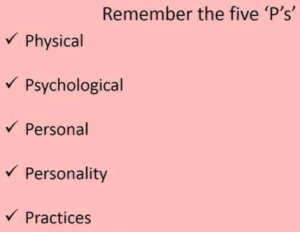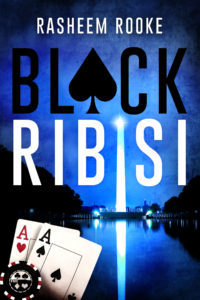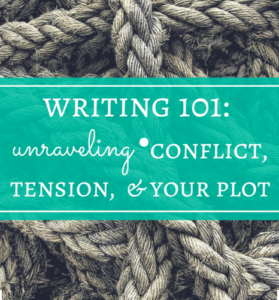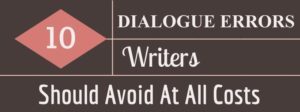Rasheem Rooke's Blog
February 19, 2018
How to Create a Fictional Character
When characters are written well, you run the risk of reading an entire novel without once giving thought to how those characters were created. You’ll simply enjoy meeting new people, page after page. One might be melodramatic, another might be stoic, and while another might be so humorous that you crack a smile at every smart quip or one-liner they deliver.
Well-crafted characters are the building blocks to your story. They are its’ DNA. The life of your novel will be dictated by how your characters interact with each other and the driving force of that interaction will be rooted in their individual personalities. Keeping this in mind, you should take the time to develop your characters, one by one.
Pay particular attention to what makes each of them different. As your characters interact with each other, those differences will cause them hate or love each other. They will become friends, lovers or enemies. Your characters will choose to build a world together, or destroy the world, a brick at a time.
Yes…character development is a VERY important element and the success of your story will depend on it. But I caution you to not over complicate the process. I’ve come across a simple tool that will help you flesh out multidimensional characters that will serve as the aforementioned building blocks. I found it while looking over many of the different websites I’ve used over the years. While I don’t know who created it, I’m including the link to the site below.
Creating a Fictional Character
I love this device because it breaks down character development by urging the writer to remember the 5 P’s.
Physical
Psychological
Personal
Personality
Practices
Take a look at the link and examine the simple chart that will walk you through how to think about each aspect of your character. It is quick to read through and easy to digest.
If you are currently writing or revamping a previously written novel, I would suggest you start mapping out a number of your characters. Start with the following:
Protagonist
Antagonist
(If the following exist)
Protagonist’s sidekick or best friend
Antagonist’s sidekick
Protagonist’s love interest
The Mentor (for either the protagonist or antagonist)
Once you’ve sketched these characters out, send it to me in a message. I’ll happily give you some feedback! Let’s see how dynamic you can get. Stay away from carbon copy characters. Like with past blog posts, you want conflict. And nothing drives conflict like characters that are opposed to each other, even to the point of being irreconcilable.
Have fun!
VISIT AMAZON.COM FOR YOUR COPY NOW
January 31, 2018
Without Conflict…All You Have Is a Boring Book (Part 2)
Last week, we looked at how dialogue requires conflict in order to move a story along and make people WANT to read. This week, I want to provide a resource that will help you dissect how conflict makes it’s way into the story through your plot. But before we go into that…I want to drop one more gem on you about writing dialogue.
While last week’s blog post focused on providing resources to help you understand conflict in dialogue, but it didn’t give you anything to show you HOW to write dialogue. Please take a look at Eva Langston’s 10 Dialogue Mistakes in Fiction and How to Fix Them. It will teach you the industry standards to writing dialogue by walking you through what your dialogue shouldn’t look like. I stumbled across this article over the week and think it’s a must read.
With that out of the way, let’s look at your plot! Kaitlin Hillerich wrote an absolutely wonderful piece on looking at conflict, tension, and plot. And that’s exactly what it’s called, Writing 101: Unraveling Conflict, Tension, and Your Plot.
As you are writing your novel, you have to keep three questions in mind. As simple as these questions are, if you lose sight of them, you will end up writing a story that no one will ever read to completion. Answer these questions and you will write novel after novel, keeping your readers glued to your story.
What is conflict?
What is plot?
What is tension?
If you can’t answer these three questions, then you’re in trouble. If you can answer them, but it takes more than two sentences, then you have overcomplicated these key concepts. Either way, your writing will suffer.
Don’t wait another minute. Read Hillerich’s article and let her provide the simple understanding of conflict, plot, and tension. She will easily and quickly walk you through examples to bring these concepts to life. Once you feel you understand them, then put them to practice in your own novel writing.
Think of that one horribly boring book that you couldn’t bear to finish reading. Well…if you don’t understand conflict, plot, and tension, that will be the fate of your book too.
January 23, 2018
Without Conflict…All You Have Is a Boring Book (Part 1)
Since publishing Black Ribisi, I have been asked to read works in progress by a few different authors. I’d read the samples and find myself asking the same question, for an overwhelming majority of the work. Where’s the conflict?!
Without conflict, all you have is boring book. Conflict is what grips a reader. Conflict is what pushes the plot along. Conflict is what keeps people awake until 2:00 AM, even though they have to be up first thing in the morning. We want our readers eager to see what happens next. What makes this possible? Say it with me…CONFLICT!
Many writers, especially first-time writers don’t put the required time and work into crafting conflict throughout their story. This can have disastrous consequences. Imagine for a moment that you’ve finished what you consider to be the greatest 90K word novel you have ever written. It’s been published! People have purchased, read, and written reviews on your great masterpiece.
You take a deep breath and delve into the reviews, only to see that reader after reader found it difficult to finish your tome. They’d read a chapter at a time, only to get into a boxing match with the sand man. They were BORED to death!
Is this the type of reaction you want to your novel? Of course it isn’t. But it will be the inevitable response if you don’t take the time to be intentional about conflict and how it’s used.
It would be really messed up of me to beat you over the head about conflict and not provide a couple of resources that will help you accomplish this. I’d like you to think about writing conflict well in two distinct areas…dialogue and plot. This post will address conflict in dialogue and next week’s post will address conflict and plot.
Understand that great dialogue in a book sounds NOTHING like dialogue in real life. Read the 9 Rules for Novel Writing article on the Novel Writing Help website. It will provide nine essential tips to writing engaging dialogue 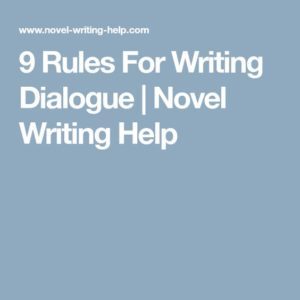 that isn’t bland and dry.
that isn’t bland and dry.
I would also challenge you to find your favorite novel, in the genre that you write. For me, that would probably be Dan Brown’s Angels and Demons. Read through sections of dialogue in the novel and pay close attention to how it’s written. Look at how conflict and disagreement is highlighted within the interaction. Very rarely will you see (or probably never):
“Hello. What’s your name?” he said.
“Hi. My name is Mary Elizabeth. What about yours?” she said.
“I’m Mark,” he responded.
“Nice to meet you Mark,” she said.
There’s no intrigue in that exchange. It lacks conflict. Instead, you might see:
The young man extended a sweaty palm and said, “Hello. What’s your name?”
“Mary Elizabeth,” she said, giggling at the gesture. She thought it was cute.
Before she could ask, he blurted out, “I’m Mark.”
That was her last boyfriend’s name. The one who left her for her best friend.
“Nice to meet you Mark,” she said with a frown.
Or you might see:
The young man extended a sweaty palm and said, “Hello. What’s your name?”
“Such personal information. I don’t think that’s any of your business.”
“Well I’m Mark.”
“That’s nice,” she said. And walked away.
Create conflict between characters and show it through dialogue. It will make for much better reading.
Next week we’ll look at how to write conflict in your plot.
January 15, 2018
How to Write Your First Chapter
Our minds have been made up! We’re going to write a novel! Since we’ve already taken time to decide on whether we’ll write an outline, be a pantser, or do some hybrid of the two writing styles, let’s now turn our attention to the all important first chapter.
First chapters are crucial to how your novel will be received by your readers. In a few short pages you can start the process of blowing them away or you could lull them to sleep. Keep in mind that readers want to be excited about your content. They want to be wowed. Readers will give you every opportunity to live up to the expectation of a great story. Think about that as you craft the beginning of your saga. Your readers will be rooting for you! It’s up to you to not let them down.
Since this is the case, put thought into how you will hook your readers from the start. View each chapter as a distinct scene. When there’s a change in scenery, then you need a new chapter. So for this first scene, be deliberate with what happens. Be intentional with regards to the dialogue, or lack thereof. Be specific when it comes to your character introductions.
Instead of boring you with my thoughts on writing your first chapter, I want to point you to two resources that do an excellent job. What Makes and Amazing First Chapter by Jeni Chappelle is phenomenal at giving you an overview of what you should be looking at and thinking of. In What Happens on Page One: 30 Ways to Start a Novel, Bryn Donovan will give you more specifics. She provides fair warning and share what you should absolutely stay away from at the start of your novel. But she will also give you thirty other ideas that make for exciting openings.
Read and take them into consideration as you begin to craft your first chapter. One final note… If you come across hypertext links in the pages that bring you to other articles, get curious and click them. The rabbit hole goes deep. You should follow it.
Click on the titles above or images below to get started.
January 8, 2018
Outline, Just Write, or Something In Between
Exactly five years prior to publishing Black Ribisi, I had grand ideas of becoming an author and writing my first novel. I created a protagonist who worked on the campus of a fictitious, but prominent, Historically Black College or University (HBCU).
I worked at an HBCU at the time. I was certain people would’ve been able to figure out the source of my inspiration, even still, I attempted to cook up a little intrigue. In the process of writing, I left details about the school extremely vague. When it was all said and done, my fake intrigue would’ve been useless, considering the working title of the novel was On Hilltop High. Anybody remotely familiar with the school I worked at would’ve known exactly where my inspiration was coming from. It was whatever. I was still determined to write my novel.
I thought about my main characters and every night I carved out time to write. I started with my original thought of an on campus murder. I fleshed out a plot that would bring together a washed up detective who was newly hired to work in the campus police department, and the person charged with enforcing the university student code violations. I even threw in a love plot between two campus colleagues. What’s a good story without a little romance?
I’d write and I’d sleep. I’d get up, go to work, come home and write some more. I’d take the weekend to write even more! One day I looked up and saw that I had over 300 pages of material. I was excited! But that excitement lasted long enough for me to flip back 150 pages to find a couple of details I needed to change in order to fix plot holes and inconsistencies with main characters. It took me hours and all I did was further confuse myself.
That’s when it hit me. I didn’t have the discipline to sit down and type out a novel by the seat of my pants. I didn’t really realize there would come a time when I would have to go back, re-read what I had written, and try to make sense of everything. That required a lot of patience, discipline, and time. None of which I had. I was lazy!
So what happened? I quickly gave up on the project. I threw the 300 plus pages in the trash, deleted the file, and gave up on my dream of being a published author. I know… I can be melodramatic at times. It wasn’t until years later that I came to learn about and understand the writing styles that would move me from melodramatic quitter to published author.
That’s where you must start. There are three distinct styles of writing that exist. Each style offers it’s own benefit and drawback. But it’s up to you to decide which works best for you or if you would benefit from a hybrid of the three. The first of the three has already been alluded to, if you weren’t paying attention, it’s the Seat of Your Pants technique.
[image error]
The technique’s title comes from the euphemism, “by the seat of your pants.” It describes when a person is acting on instinct versus thinking things through in a logical manner. If this is your preferred writing style, then that’s exactly how you’ll move through your draft. You’ll crack open your laptop, and without a sketch, an outline, or map of events written on a napkin, you’ll start to tap out your bestseller. Some writers excel at this style because it allows them to create their first drafts quickly. It also gives them the flexibility and freedom to go wherever their mind will lead.
This process wouldn’t work for me because as I said earlier, I don’t have the discipline to go back through an entire novel and then make sense of it. It also doesn’t work for me because of my creative thinking process. It requires time to develop plots. I know people who can sit at a computer and type, non-stop, without prior thought being put into what they’re typing. Not me. I need to sit and think, make sense of it in my brain, and then type it out.
Another writing style is Novel by Outline. This is me, all day long. I require a carefully constructed outline that moves my from chapter to chapter. What works best for me is a brief summary describing what happens in each chapter. In an earlier blog, I said that the draft of your novel needs to have a beginning, middle, and end. The same thing must exist for each chapter. During the outlining phase, I can sketch out how each chapter starts, what pivotal things happen during, and how each chapter ends.
This process works wonders for me because it serves as a road map to keep me focused and bring me to the end of my story. I also no longer have to worry about what happens next. I know what happens next! But just like the outline of portraits in a coloring book, I’ve got to use the crayons of my imagination to color in the story.
What tools can you use to make create your outline? That’s easy…Microsoft Word or Microsoft Excel. Each of these programs can be formatted to allow you to outline from Chapter One until infinity! Whether you do it in the word processing format offered by MS Word, or the cell format by MS Excel, you can create the linear progression you need. It will make it easy for you to jump between chapters to flesh out ideas, plots, characters, and leave dialogue clues to ensure important statements aren’t missing.
For the outlining and the writing stages of my novel writing, I use a software program called Scrivener. I strongly urge you to look into the program. It has been the best writing tool I’ve used thus far. I would do a disservice trying to explain all the details, so please click the link for more information. All I’ll say is that it’s an inexpensive way to organize everything you need for the purposes of writing your novel. And then it’s a great platform to easily write and format the book. (FYI…I don’t get paid for any tool or book I suggest! I just truly believe in their effectiveness.)
The Novel by Outline process is a simplified version of the Snowflake Method by Randy Ingermanson. While there are many preferred styles of novel writing, this is the third and final method that I’d like to highlight. Ingermanson takes his readers through the process of outlining their novels in stages. It’s like outlining on steroids! His website will walk you through a summary of what those phases look like.
[image error]When I came across Ingermanson’s Snowflake Method, I pretty much got everything I needed to start Black Ribisi through his summary page. He offers a lot of detail! But I ultimately purchased the book to get more information and to support the process that led to the ultimate completion of my debut novel.
I mentioned earlier that you should have a preferred style of writing, but there’s nothing wrong with merging the styles to find something that works just right for you. At the start of Black Ribisi, I had an idea and was a “pantser” for the first 80 pages. I stopped at that point and outlined the rest of the book. I used portions of the Snowflake Method in the beginning, and then leveled off to a regular outline. And guess what? It worked! Now I have a novel that’s averaging 5 out of 5 stars on Amazon!
Take your time to look through the resources I’ve provided. I’m certain they will help you start your novel writing process!
January 1, 2018
Where Do You Start?
You’ve made up your mind. Today is the day! You’ve long held a dream that you would be an author and today is the day that you’re going to start your journey. You grab your MacBook Air, Bluetooth headphones, and head to the nearest Bus Boys and Poets. That’s where all the DC writers write, right? This is your day to start.
You find a comfortable chair. You order the Chipotle Grilled Chicken Panini sandwich and some version of an herbal tea. Maybe peppermint. It really doesn’t matter. The type of tea you drink will bear no weight on what’s about to go down. Today is YOUR day. You’re starting to fell like an author already.
The food comes and you eat. Your favorite artist plays on Spotify and you listen. You people watch for almost an hour and a half. Then you spark conversation with a welcoming soul who is just a chair away. But after three hours, you leave Bus Boys and Poets no closer to your goal of becoming an author. No characters were created. Pages weren’t written. Plot twists and dialogue fell victim to good intentions. But alas, no story.
What happened?
While I can’t put my finger on the exact root of the problem, I do know that oftentimes we fall in the trap of not knowing where to start. Writing a novel is journey that requires some form of movement in the beginning. Whether large or small, movement is needed, nevertheless. Lao Tzu wrote in the Tao Te Ching, “The journey of a thousand miles begins with a single step.” The same can be said for novel writing. The journey toward an 80,000-word novel begins with a single word. And that single word is powerful enough to compel you toward a completed project. You need a starting point.
Starting points will differ from author to author. Marian Schembari published a blog post a couple years ago titled, How to Start Writing a Book: A Peek Inside One Writer’s Process. She offered some excellent advice that will help you start your writing process. But I must say, I really love Step 1! She says, “Procrastinate writing by READING about writing.”
Authors who don’t read about the process of writing will rarely be effective writers. Procrastination is a part of the writing process. Every writer goes through it. Take the time now, to commit yourself to the reading, research, and study of the craft of writing, during those times of procrastination. No matter how gifted a writer you are, you can always benefit from reading about the craft.
The first two books (which were invaluable) I read about novel writing are:
How Not to Write a Novel: 200 Classic Mistakes and How to Avoid Them – A Misstep-by-Misstep Guide by Howard Mittlemark and Sandra Newman[image error]
This book showed me everything I wanted to stay away from as a storyteller. The focus on plot, character, and style made me familiar with the individual elements of the story. And as a novice writer, it made me more comfortable with performing surgery. I needed to be able to identify these different elements in order to cut out anything that didn’t add value to my novel.
No Plot? No Problem! A Low-Stress, High-Velocity Guide to Writing a Novel by Chris Baty
[image error]The founder of the world’s largest writing event, the National Novel Writing Month (NaNoWriMo), wrote this book. The NaNoWriMo takes place every November. Countless authors from all over the world, commit to using the month to write a new novel of 50,000 words or more. Writers of all skill levels accept and complete this challenge. And plenty of other writers accept and fail. The book is a great tool for writers to help them move from a blank page to a finished product.
While I didn’t take part in NaNoWriMo, this was still a great book to read because it gave me a perspective on novel writing that I share with everyone who asks me about writing a book. Our job as writers is to simply write the damn book. Write a beginning, middle, and end. Crank out a first draft. We get so caught up in revising as we write, that we never make it past the first twenty pages. But this book drilled into my head the importance of killing the need for perfection.
One of my favorite quotes is from Ernest Hemingway. “The first draft of everything is shit.” Well if that’s good enough for Hemingway, then that’s good enough for me! At the BEGINNING of our novel journey, we need to start with the idea that what whatever we write in FIRST DRAFT form, will be perfected through later revisions. Where do you start? Start by writing something. Anything! It’s been said that you can’t revise a blank sheet. And it’s true. Your number one job is to write your story. Get something on the page and you’ll make it a masterpiece later.
In the next post, I’ll walk through the different styles of writing. It may help identify your preferred style. Are you an outliner, like me? Can you just sit down and write off the top of your head? Are you a combination of both? And the post after that… Writing your first chapter!
In the meantime, read Marine Schembari’s article and check out the books I mentioned. If you like, find your own resources on novel writing. Read about the craft now because you’re going to be writing in no time!
Rasheem-
There’s a Novel Inside of You
Have you ever wanted to write a novel and thought to yourself, “I don’t know the first thing about novel writing. Where do I start?” Believe it or not, that’s a question many first time authors ask. Many of us begin with what we consider a great idea, but we’re lost when it comes to developing a plot, building believable characters with compelling backstories, and crafting dialogue that’s exciting and moves the story along. Writing a novel can be a frightening experience. It’s even more so when you don’t know what you’re doing.
[image error]
That’s where this blog comes into play!!!
Each week I will post different tools that will help you with an element of novel writing. Whether you’re interested in writing romance, fantasy, suspense (like me!), or something completely different, my blog will introduce you to what you need. All of the articles and posts are bits and pieces I came across that helped me in my own journey to becoming a published author. All I want to do is share the wealth. Read my blog and go from blank page to published author in no time.
I’m going to cover as much as I can, but if you don’t see a topic, or you think of a topic you’d like to read, shoot me a message and I’ll find it! I will post links to articles from industry experts, give my thoughts on the topics, and summarize important points. This will be your one-stop shop for creating your masterpiece.
Are you ready to get to work? If so, continue reading on to the next post… your masterpiece awaits you.
Rasheem-

